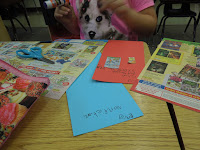During our study on the oceans, we have been learning to distinguish between fiction and nonfiction texts. The students are getting very good at not only telling you if a book is fiction or nonfiction but also showing you evidence to support their thinking. In the pictures below, students are sorting books into fiction and nonfiction and explaining their thinking to their group members. Second graders also went through our recent book orders to do some sorting.

We made a class anchor chart with some of the defining characteristics of fiction and nonfiction texts. Students also demonstrated their understanding of fiction and nonfiction in their vocabulary notebooks.

While making the fiction/nonfiction distinction is a first grade performance standard, we dove a deeper into the second grade standard of knowing different features of nonfiction text and how those features help locate important information.


To discover different features of nonfiction text, we have been going fishing! Inside a fishing net I have placed examples of different nonfiction features like a caption, map, diagram, bold print, headings, etc. A student comes up and sticks their hand in the net to grab a feature. They have to be quick though, the fish are fast and slippery and you always have to be careful of being bit! Ha! Mr. Palmer knows how to build suspense...can't you hear him humming the Jaws theme?


We will continue to explore more features into next week. When you are reading at home, ask your child if the books are fiction or nonfiction and listen to their reasoning skills. See if they can point out any features.







No comments:
Post a Comment